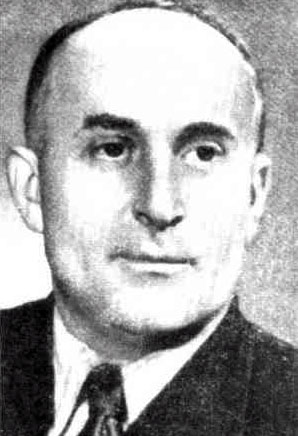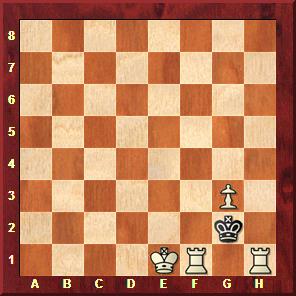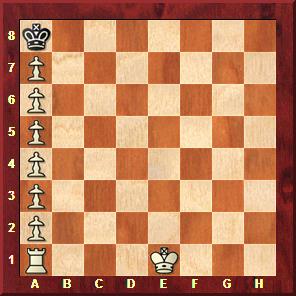A Merry Christmas to all our readers
Or a Happy Christmas if you are British or Irish, or Season's Greetings if you are secular. Our tradition of presenting you with a week of chess puzzles during the Winter Solstice has been going on for fifteen years now and traditionally started with an ICQ Christmas greeting.

These are animated Flash greeting cards, and you can watch "Santa's time machine" above by clicking here. If you become addicted you can play through a few more we used in the past: like this international Merry Christmas, or the rooftop song.
Well, on to the puzzles. As many of you know until last year this well-loved section was published in static HTML, and disappeared into oblivion when we switched to a new content management system. We started to republish some of the older articles, which you can view here. For the fifteenth anniversary of the Christmas puzzles we have decided to go back in time and pick some of the best or most popular puzzles for you. Remember some our GM readers (and one of our regular authors) were not born when we started the series. For older readers the cherries we will pick out of the original section will hopefully bring on nostalgic memories; and the younger ones will learn for the first time what we have been up to over the years.
And of course we will start the new year with our traditional Christmas puzzle contest. On the first of January 2015 you will get some problems to solve, with the chance of winning interesting prizes.
ChessBase Christmas Puzzle 1999
It would be appropriate to start our review of fifteen years of Christmas puzzles with the very first one, which has been entertaining people for a decade and a half. It is the infamous 1999 ChessBase Christmas Puzzle, given to us at the time by John Nunn:
A game begins with 1.e4 and ends in the fifth move with knight takes rook mate.

This is the starting position. All you have to do is enter some legal chess moves, so that the game ends on move five with the stipulated knight takes rook mate. We republished this problem and retold the epic story around it in August last year. You can find out how the strongest players in the world were able to cope with it.
December 25, 2014: ChessBase Christmas Puzzle 2000
|
A game ends with the move
6.gxf8=N mate. How did it go?
|
That's it. An astonishingly simple task. You must find just six moves from the starting position in chess, that lead to a white pawn moving from the square g7 to f8, capturing a black piece that is located there,
promoting to a knight and delivering mate. Naturally it is not a forced sequence – both sides cooperate to achieve the goal. If the conditions are not completely clear, here is an expanded explanation.
The game starts from the initial position. White and Black execute five moves each. Then, on move six, White moves a pawn from the square g7 to f8, capturing a black piece that is located there, promoting to a knight and delivering mate in the process..

The moves must all be legal, no side may ignore a check. As mentioned above White does not force the move sequence – both sides cooperate to achieve the goal.
December 26, 2014: from ChessBase Christmas Puzzles 2001
1. Identify this game
Here is a very famous game, or rather a small extract of it. The replay board only shows the moves of the black knight in the course of the game, as does the diagram on the right. This knight was absolutely decisive. It tore into the white position, creating mayhem and winning the encounter for Black. Your task is to identify the game and the players. It is one of the best-known games in chess history.
2. The deadly knight
Chess studies are often profound, subtle or instructive. But some are just plain fun. Here's an example in which you can do what you probably often dreamed of in your regular club games. Go for it, have a ball!
J. Mendheim, Berlin 1932

White to play and win
December 27, 2014: from ChessBase Christmas Puzzles 2001
 |
Genrikh Moiseyevich Kasparian
He was born in Tiflis in 1910 and died in 1996. Genrikh Kasparian learned chess from his older brother at the age of 13, became a strong master and then devoted his life to the game. But not to over-the-board play but the composition of some of the greatest chess studies ever to be seen.

Postage stamp "Birth Centenary
of Henrik Kasparyan", Armenia 2010
|
The depth of Kasparian's ideas and the artistry of execution has never been surpassed. Of the 400 studies that we have by this great composer around 300 received prizes and awards. He was a Grandmaster for Study Composition and six-time Champion for study composition in the USSR. Here is my all-time favourite Kasparian study:
Genrikh Kasparian, Shakhmaty v SSSR 1935

White to play and win
Feed the position into your chess program and it will give you the solution instantly. BUT: if you use electronic assistance you will miss the experience of a lifetime figuring out how White can bring about a clean win. Spend a half-hour working it out from the diagram, or better still: fetch a chessboard and pieces and figure it out on your Christmas table.
Samuel Loyd (1841–1911) was not just the greatest American problem composer. He was probably the greatest problem composer the world has ever seen. Loyd published over 700 chess problems, many with humorous or unexpected solutions, the likes of which had never been seen before. William Anthony Shinkman (1847–1933) is America's second great chess problem composer, brilliantly original and incredibly prolific – he published over 3,500 problems of many different types.
Samuel Loyd, New York Albion 1857

White to play and mate in three moves
|
W. A. Shinkman, St. Louis Globe Democrat 1887

White to play and mate in eight
|
Sam Loyd's biographer, A. C. White, calls this "one of the world's most famous problems". Loyd, who published the problem before he had turned 16, referred to it as "a neat little position". You will need a tiny bit of lateral thinking in order to solve it.
The Shinkman problem is a beautiful, almost architectual position. Another great composer, Werner Speckmann, mused that "one might think the the rules of the present-day game of chess had been especially invented to produce this problem". Unfortunately a second solution (or "cook") was later found. But for once this does not seem to have destroyed immortality of the problem. When you find the solution that the author originally intended you will immediately recognise its beauty. The cook is ugly and convoluted.
Incidentally Shinkman originally intended the position as a retro-analytical exercise, not a classical mate problem. The question was how can one achieve the above position in a normal game of chess, only executing legal moves. It can be reached in 34 moves from the initial position. Naturally both sides must cooperate to achieve the goal. This task is only for experienced problem experts.
December 28, 2014: from ChessBase Christmas Puzzles 2001
 |
How did that happen?
"Retrograde analysis" sounds daunting, but is it a very enjoyable form of recreational chess, requiring humour and lateral thinking.
One of the great masters of the retrograde problem was T. R. Dawson, but the genre was brought to mainstream attention in a series of books by Raymond Smullyan entitled "Chess Mysteries of Sherlock Holmes". They appeared in Hutchinson around 1980.
Smullyan's chess puzzle books are written in the style of the Conan Dolye tales. The presents problems that require the same kind of logic the master detective employed to track down his criminal adversaries. Typically Holmes and Watson will find an interrupted game and discuss how the position on the board came about.
Raymond Smullyan is a well-known American mathematician, concert pianist, logician, Taoist philosopher, and magician. He is the author of many books on recreational mathematics and logic. And the one shown on the left. The introductory puzzle on the cover is given below. Here's how it is described in the book:
|
I had a memorable evening alone with Holmes, during which I learned more about retro-analysis than perhaps on any other occasion. "Here, let me set up a little exercise to illustrate the more normal type of situation," he said.

What was Black's last move?
“I call this an ‘exercise', Watson, since it is really too simple to dignify by the word ‘problem'. As you see neither side is mated – nor even in check. The question now is this: Given that Black moved last, what was his last move, and White’s last move?”
I thought for a while, then said, “Holmes, I’m sorry to be such a slow pupil, but the situation again seems impossible! Obviously Black just moved out of check from a7, but I don’t see how White could possibly have moved his bishop to administer the check!”
“Not bad, Watson; not bad at all! I see you are beginning to think. But why do you have this persistent habit of forgetting that a move may involve a capture?”
Then, of course, I saw it. “Right, Holmes, right. Black’s last move was with the king from a7 capturing a white piece on a8. This piece must have moved before that out of the diagonal from g1 to a7 to uncover check from the bishop. What piece could that be? Why obviously a knight, which had moved from b6 to a8. Thus Black’s last move was from a7 to a8, capturing a white knight.”
“Correct,” said Holmes.
A new thought suddenly occurred to me. “Holmes” I said, “is it really necessary in this problem to be given which side was White?”
“Of course,” replied Holmes. “If we hadn’t been given that information, then a second solution would have been possible: A white pawn could have just promoted to bishop.”
A retro problem for Christmas
Raymond Smullyan, Manchester Guardian 1957

In the above position White has just removed his king from the board.
From which square, and what were the last two moves?
Once again we entreat you: do not post any solutions in the discussion section below and spoil the fun for everyone else. Nobody will admire you for it, and some will be extremely annoyed. Just keep it to yourself.










































